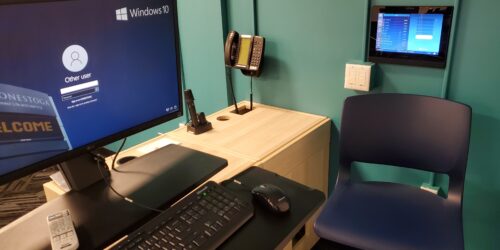
Implementing BOPPPS Framework in the Hybrid Classroom
In teaching, we often utilize teaching frameworks to enhance our instructional approaches and promote student engagement. BOPPPS is a common framework that provides a structured approach to planning your lesson in an engaging manner that creates effective learning experiences for your students. When incorporating this framework into a hybrid class, you need to adopt a distinct perspective on students’ learning and take into account the blended modality. This teaching tip will explore how the BOPPPS model might look during a typical hybrid week.
B: Bridge-In
This initial step is where you want to grab student’s attention. You want to support their understanding of why their lesson topic matters and why they should value this learning opportunity.
In your hybrid course, you could start the week with a short, engaging activity or pose a question related to the upcoming content. For example, you could ask them to complete a Mentimeter question before they come to class, which was shared as an announcement in the course shell. You could also ask them to watch a short video before they come to class that connects the weekly topic to a real-world application. Having students complete this task before coming to class is your opportunity to pique their interest in the weekly topic and motivate them to come to class and engage with the content and their peers.
O: Objective
This is where you clearly state the outcomes for the week. One approach is to share these outcomes at the start of the synchronous class and make sure students understand the connection to what they will be able to do by the end of the hybrid week. You can also share these with your students online in the eConestoga course shell under the weekly module. Be sure to orient students and remind them of these at the start of the synchronous class.
P: Pre-Assessment
In this step, you will assess the students’ prior knowledge and understanding of the weekly topic. You can also use this opportunity to connect their existing knowledge to the bridge-in task. For instance, if you assigned students a short video to watch before class, consider asking them about their key takeaways from the video. Additionally, encourage them to reflect on how the video relates to the topic you’ll cover in class. Another approach is to have students share their reflections asynchronously on a Padlet board, which you can then review as a class during the synchronous learning. These strategies will help you gauge their starting point of understanding.
P: Participatory Activities
In this stage of the framework, students actively engage with the learning outcomes, fostering a deeper understanding and connection to the lesson. Participatory activities can encompass a blend of synchronous and asynchronous approaches. Synchronous activities leverage in-person time with peers and faculty, offering interactive discussions, group work, simulations, and demonstrations. Asynchronous activities facilitate self-directed learning, including assigned readings, collaborative projects using tools like Teams, and participation in educational platforms such as Padlet or Mentimeter. Give thought to how you can create a fusion of engagement through these modalities!
P: Post Assessment
In this stage of the framework, you evaluate how effectively students have achieved the identified learning outcomes. Post-assessments can be completed during synchronous classes following participatory learning experiences. These formative assessments may be either ungraded or graded and can take various forms, such as short quizzes, brief presentations, or reflections. Additionally, students can complete these assessments outside of class as part of asynchronous tasks, including online quizzes, discussion forums, written reflections, or concept maps.
Teaching tip! These post-assessments do not need to take a lot of time. Check out this resource on 90-second assessments.
S: Summary
In this final stage, you’ll highlight key points from the week. You can do this at the end of the synchronous class or share it in the course shell as part of asynchronous learning. Your summary should relate student learning back to the stated learning outcomes and provide a glimpse of what’s to come in the next synchronous or asynchronous session.
Teaching Tip! The steps of BOPPPS can be targeted during each class or scaffolded across multiple classes in the various modalities. In a 50-minute synchronous class, you can go through all of the BOPPPS steps, or you can have the framework overlapping in synchronous and asynchronous learning.
You are encouraged to explore the diverse ways in which you can incorporate BOPPPS into your weekly hybrid class. Try new approaches and seek feedback! With careful pedagogical planning and consideration of supporting students with their face-to-face and asynchronous learning, you can effectively implement the model throughout a typical hybrid week.






